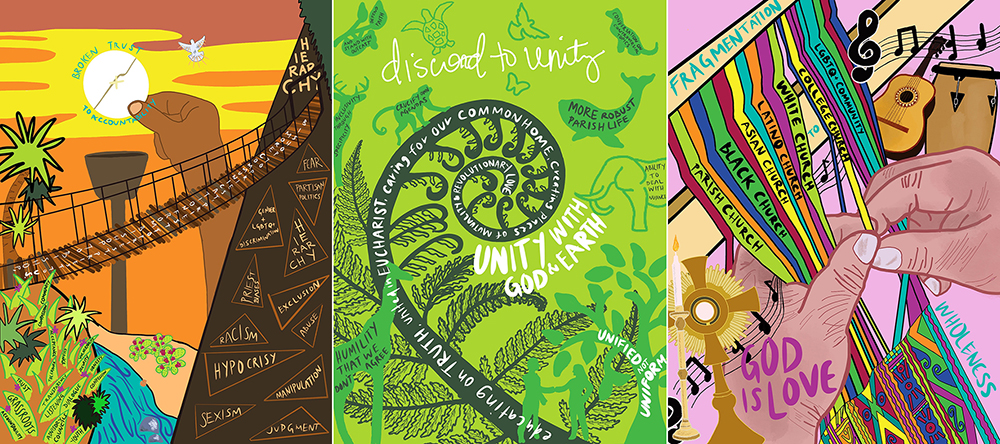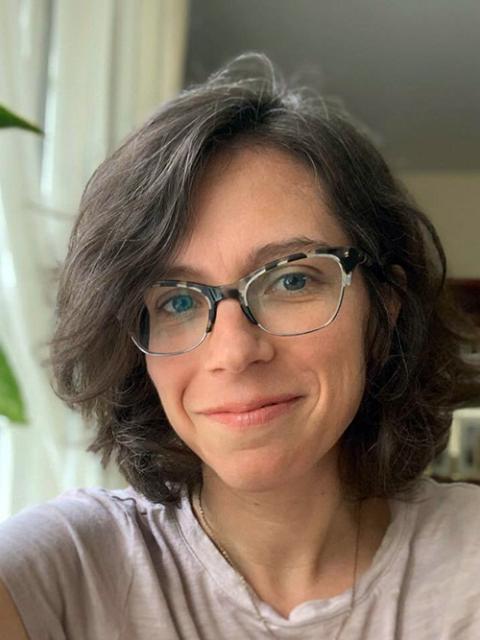
Digital art pieces created by Becky McIntyre after Philadelphia-area higher education Synodal listening sessions (Images courtesy of Becky McIntyre)
When Pope Francis called two years ago for a worldwide discussion among rank-and-file Catholics about the main challenges and issues facing the church, the question of women's ministry and leadership echoed loudly in parishes and bishops' assemblies.
The question is resounding more loudly as the summit of bishops and lay Catholics known as the Synod on Synodality, scheduled for October, draws near. Participants and observers alike recognize that any conversation about reforming church hierarchy or promoting lay involvement, Francis' twin goals for the synod, has to include honest exchanges about the role of women.
"It's not just one issue among others that you can tease out," said Casey Stanton, co-director of Discerning Deacons, a group committed to promoting dialogue about the female diaconate in the church. "It's actually kind of at the heart of the synod and we need to take a step forward that is meaningful, and that people can see and feel in their communities."

Casey Stanton (Courtesy photo)
Stanton believes that opening the door for women to become deacons — allowing them to oversee some aspects of the Mass but not consecrate the Eucharist or perform other duties reserved for priests such as anointing the sick — could send an important signal to Catholics that the Vatican is listening to their concerns.
The upcoming synod already gives a greater role to women, who will be allowed to vote for the first time in any such meeting. Of the 364 voting participants, mostly bishops, more than 50 will be women. But women were never the intended focus of the synod, a project Francis hoped would inspire discussion of a "new way of being church," which was interpreted to mean a focus on church power structures and rethinking the privilege enjoyed by clergy.
But by the end of the last phase of the synod, when gatherings of bishops divided by continents examined the topics brought up at the grassroots level, it was clear that the question of women had taken center stage. The document that emerged from those discussions, with the telling title "Enlarge Your Tent," spoke to the "almost unanimous affirmation" to raise the role of women in the church.
The document described the peripheral role played by women in the church as a growing issue that impacted the function of the clergy and how power is exercised in the historically male-led institution. While it made no mention of female ordination to the priesthood, it did suggest that the diaconate might answer a need to recognize the ministry already offered by women all over the world.
"It's remarkable the shared cry that came through in 'Enlarge the Space of Your Tent' around the deep connection between creating a new synodal path in the church and a church that more fully receives the gifts that women bring," Stanton said.
Advertisement
When, in June, the Vatican issued its "instrumentum laboris," or working document that will guide the discussion at the synod, it explicitly asked: "Most of the Continental Assemblies and the syntheses of several Episcopal Conferences call for the question of women's inclusion in the diaconate to be considered. Is it possible to envisage this, and in what way?"
Attributing the question to the continental assemblies and avoiding the words "ministry" and "ordination" in asking it, said Miriam Duignan, co-director of Women's Ordination Worldwide, constituted a "preemptive strike" against open discussion of priestly ordination.
This avoids a direct challenge to the Vatican, which has shut down the possibility of women's ordination many times.
In 1976, the Pontifical Biblical Commission established that Scripture did not prevent the ordination of women and voted that female priests did not contradict Christ's vision for the church. But soon after, the Vatican's doctrinal watchdog, the Congregation for the Doctrine of the Faith, intervened to state that the church was not authorized to ordain women.
Pope John Paul II had the final word on the issue when he definitively stated that "the Church has no authority whatsoever to confer priestly ordination on women," in his 1994 apostolic letter "Ordinatio Sacerdotalis" ("Priestly Ordination").
Francis and synod organizers have emphasized that the synod has no intention of opening that door. "For the Catholic Church at this moment, from an official point of view, it's not an open question," said Sr. Nathalie Becquart, undersecretary at the Vatican's synod office, in an interview.

Sr. Nathalie Becquart poses for a photo in Rome on Feb. 10, 2021. (AP/Alessandra Tarantino)
The question of the female diaconate, however, remained open. Pope Benedict XVI changed canon law in 2009 to clarify the distinction between priests and bishops, who act as representatives of Christ, and deacons, who "serve the People of God in the diaconates of the liturgy, of the Word and of charity."
"Benedict predicted that the call for women priests and ministry was going to get stronger and stronger," Duignan told Religion News Service on July 25 in a phone interview.
The demand for women deacons was an underlying topic during Francis' previous synods on young people, the family and the Amazonian region. Francis created a commission to study the possibility of women deacons in 2016, and when no clear results emerged, he instituted another in April 2020.
According to Duignan, the commissions were "set up to fail," since a decision on the matter required a unanimous vote. While it's undeniable that women deacons existed in the early and pre-medieval church, theologians and historians remain divided on whether women were ordained deacons or if they occupied the role in a more informal way.
"There were women deacons in the past. We could do it again," Stanton said. "Let's just settle that."
The division on the question means that Francis will likely have to decide. "Our prediction is that there is going to be a bit of a stalemate between those bishops who fear a diaconate role for women, and those who say now it's the time, let's give them the diaconate," Duignan said.
Advocates for female deacons hope the pope will finally welcome the demand felt by many Catholic women. "For many young people it has become untenable," Stanton said, "an obstacle to feeling the gospel."
The pope could leave the decision to individual bishops, which would create a patchwork of policies. Stanton, who has witnessed many experiments for new ministries for women, said that while one bishop may open new opportunities for women, the issue will "wither on the vine" if another bishop doesn't see it as a priority.
In the end, she added, "it's one cleric getting to determine the scope of a woman's vocation and ministries."

Pope Francis is pictured at the Vatican on May 25. (AP/Andrew Medichini)
"There were women deacons in the past. We could do it again. Let's just settle that."
— Casey Stanton
Historically, the path to priestly ordination follows the steps of lector, acolyte and deacon. In January 2021, Francis allowed women to become lectors and acolytes; a decision in favor of female deacons could signal a cautious opening for the cause of women priests.
"The glacial pace for change in the modern Catholic Church means we have to accept any steps forward as progress," Duignan said. The female diaconate would in her opinion offer some recognition for the women who catechize, evangelize and assist faithful all over the world.
"Once they start seeing women at the altar in an official role and seem to be leading the Mass there will be more calls for women priests," she added.
Advocacy groups such as Women's Ordination Worldwide will be in Rome in October to make their demands known through vigils, marches and conferences. The Synod on Synodality will draw the attention not just of Catholics but women everywhere, putting the question of female leadership in the church and beyond in the spotlight.
"The women are coming," Duignan said. What remains unknown is whether the Vatican is prepared.






